It’s winter in Maryland. In fact, it’s so much winter I shoveled 10 inches of snow off my driveway this morning. Fortunately, I had company. It wasn’t the kind of company that picks up a shovel and helps out, but still, the American robins darting back and forth over my head were still welcome (if surprising and surprisingly quiet) snow day companions.
Become a Member
Make a lasting impact for nature when you join The Nature Conservancy
“You know,” I said to them as I leaned on my shovel to watch about 25 birds flock together in my neighbor’s oak. “I think y’all are a little early—aren’t you supposed to be the first harbingers of spring?”
We’re not even a month past the first day of winter in the northern hemisphere. Spring is definitely not here. So why are the robins? Shouldn’t they be sunning themselves in warmer climes?
The short answer: as long as there’s food, American robins—true to their name Turdus migratorius (“the wandering thrush”)—kind of spend their winters coming and going as they please.
Robin Migration (AKA Robin Wandering)
Robins do migrate—but they don’t necessarily follow a more or less straight line from north to south in the fall, then repeat the journey south to north in the spring. In the fall and winter, when the ground freezes, robins lose access to their meal of choice: worms, insects (adult and larval) and (occasionally) snails. That’s when they turn to their winter diet staple: mostly fruit, mostly berries.
The folks at Journey North, a project tracking robin movements run by the University of Wisconsin-Madison, put it this way, “Some robins retreat all the way to southern Texas and Florida (in fact, some of the largest winter flocks documented by the Christmas Bird Count gather in sunny St. Petersburg, Florida), but others winter as far north as they can find berries. So they have an enormous winter range. Robins do migrate, but it has more to do with food sources than with being faithful to the same places year over year.”
In that way American robins are somewhat akin to teenage boys—they tend to go where the best (or most abundant or most easily accessible) food is, stay until it’s depleted, and then move on.
So as long as there are enough berries and other fruits to sustain them, you may see robins off and on throughout the winter across much of North America.
Forget the birdseed though. Robins’ digestive systems, unlike sparrows or other so-called feeder birds, aren’t built for dealing with seed, and their beaks aren’t built for cracking things open. Robin beaks are built for snapping up worms, catching insects, and plucking berries and other fruits. In the winter, a flock of robins can strip a holly bush with impressive speed and efficiency, and very little—if any—violent robin-on-robin aggression.
Food is also one of the reasons that robins, notoriously territorial and aggressive in breeding season, tend to gather and travel in flocks in the fall and winter. Numbers are good for defense, and also for spotting food—if one robin happens on a holly tree full of bright, ripe berries, the whole flock can partake. And then move on.
The tendency of robins to flock in winter may also be one of the reasons people seem to notice them—birds in large numbers tend to stand out when they’re gathered in leafless trees. (That and the beautiful red breast that is sometimes the only splash of color in a winter landscape that looks practically lunar in relentless shades of February white and gray.)
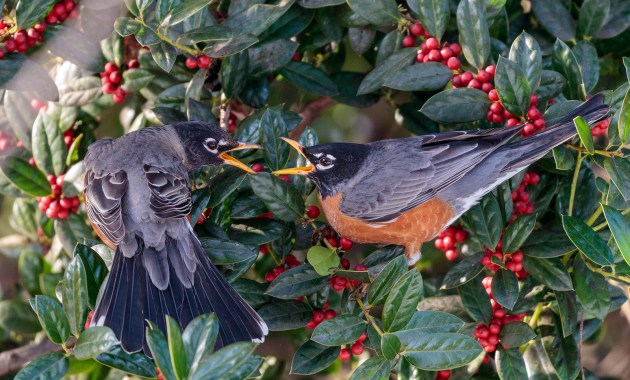
How do Robins Survive the Cold?
Robins are outfitted to survive huge temperature variances. In fact, hot weather seems to stress them more than cold.
If an American robin is healthy, has enough to eat, and is able to main its feathers, the temperature next to its body stays around 104 F—regardless of how cold it is in the world outside. It really is all about those feathers. (And the legs and feet.)
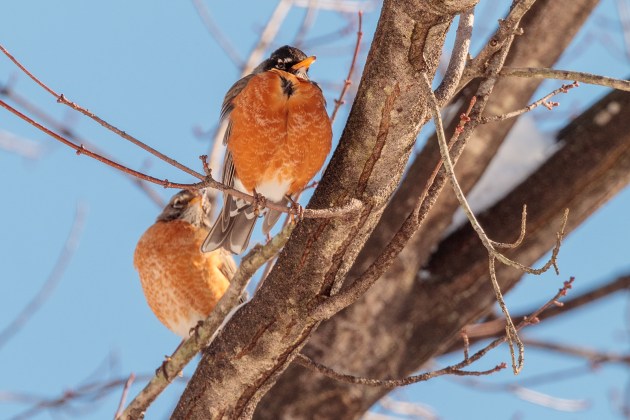
Robins, like most birds, have layers of feathers that perform different functions. When temperatures drop, robins puff the fine, downy feathers closest to their bodies to keep heat in, cold out. The outer feathers act like a kind of overcoat, shedding water and moisture and helping to regulate the bird’s temperature. (It’s an adaptation not limited to robins. Most birds with down feathers fluff them to regulate body heat).
The anatomy of a robin’s (and other bird species) also contributes to their cold adaptations. The bird experts over at the Cornell Lab explain it very well. The simplified version is that “most birds don’t succumb to frostbite because there is so little fluid in the cells of their feet, and their feet are mostly tendons and bones with little muscle or nerve tissue.”
So while blood does flow to their legs and feet, most birds (including robins) benefit from a very fast circulatory system and a “countercurrent heat exchange system.” Because bird legs are thin, the vessels that move blood from the heart to the feet and back again are very close together. That proximity means, per Cornell, “blood flowing back to the body is warmed by blood flowing to the feet. The newly cooled blood in the feet lowers heat loss from the feet, and the warmed blood flowing back into the body prevents the bird from becoming chilled.”
Robins: The Tell-Tale Birds of Spring
If robins are around in winter, why have they always been associated with the beginning of spring in the U.S.? Most likely it has to do with ground thaw, snow melt, and territorial behaviors like singing, worm hunting and nest building. But mostly, it’s the singing.
According to Journey North, which has a fantastic Q+A section I highly recommend for the robin-curious, “the robin’s song remains a reliable indicator that the first wave of spring migration has reached you. This song is one of the first signs that robins are switching from winter behavior to courtship and nesting behaviors associated with spring.”
Robins tend to move north as the ground thaws. The availability of high protein prey, especially worms that emerge with warmer, often wetter weather, is when a robin’s thoughts turn to procreation. And that’s the end of the cooperative fall and winter behaviors.
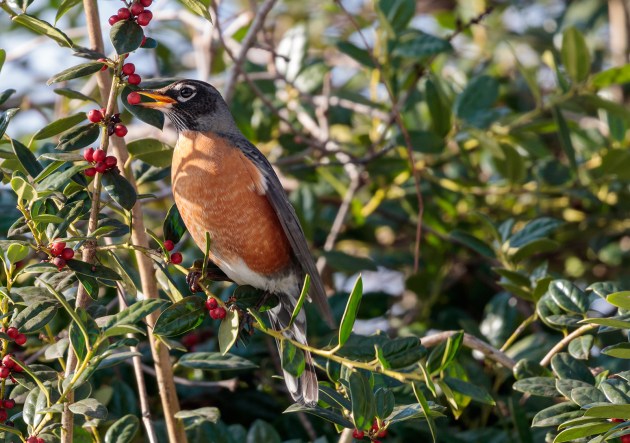
Which is one of the reasons many robins (primarily males) may stay through harsher winters instead of booking it to St. Petersburg: first access to the choicest nesting grounds. Breeding season is when robins also become more visible with mating displays, nest-building and a lot of time on the ground hunting for the tastiest worms. Until then, they’re all about the berries.
You Can Help Robins with Science from Your Own Backyard
Like many species, including other birds, scientists are starting to see some changes in robin behavior that is likely attributable to climate change. One study of American robins migrating to and from Canada’s boreal forest, showed that they’re beginning to journey south on average about 12 days earlier than in past years, or five days earlier per decade since 1994.
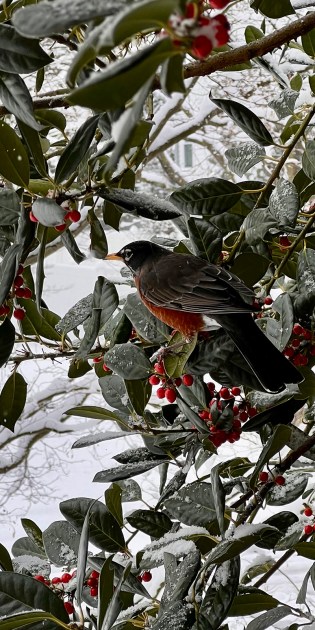
If you want to help scientists studying birds, there are several ways to contribute your observations (not just for robins, but for many of the species you can see outside your windows).
Journey North
You can submit your robin observations directly on the Journey North site (and check out their other migration-related citizen science projects). They also have 2025 maps tracking sightings so you can see where American robins (and other signs of spring) are being observed and follow along (and contribute to) the wanderings of Turdus migratorius.
Cornell Lab of Ornithology
The Cornell Lab has a number of different ways you can contribute to science for birds. Your sightings tracked on eBird (free) contribute to worldwide data for birding, science, and conservation. Want to know what birds are being seen in your neighborhood, eBird has a feature for that. If you’re new to birding, check out their genius birding ID app, Merlin.
You can also contribute to Project FeederWatch (requires subscription) by counting birds at your feeder from November through April. Your observations help scientists monitor changes in the abundance and distribution of birds, including the influence of changes in habitat, disease, and climate.
And mark your calendars for the 2025 Great Backyard Bird Count (February 14-17). Spend time in your favorite places watching birds—then report them to Cornell! It’s easy to participate, “in as little as 15 minutes notice the birds around you. Identify them, count them, and submit your counts to help scientists better understand and protect birds around the world. You can see the results from 2024 here.
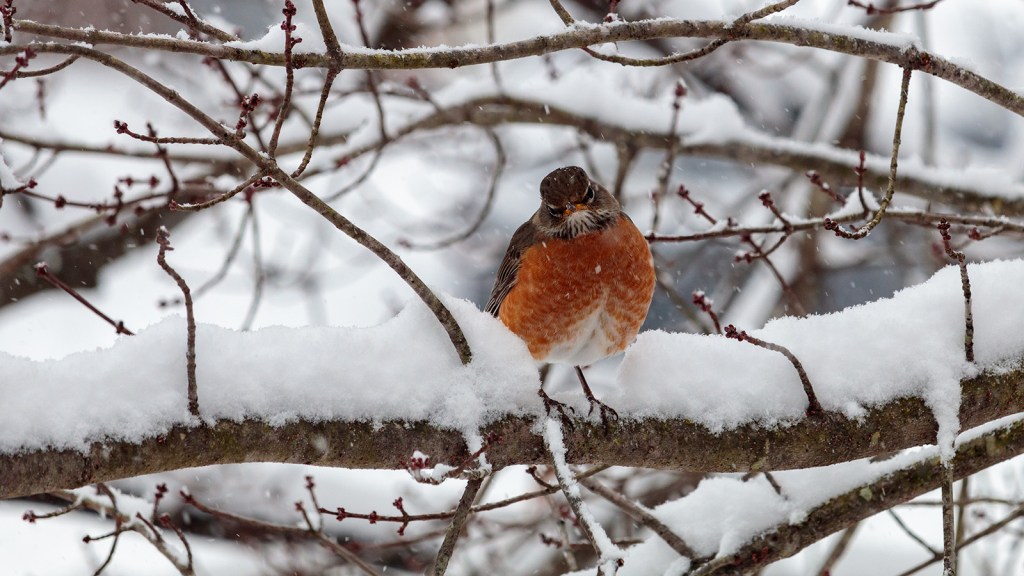



Winter here in OK. We’re in the single digits which I’ve never experienced here in Stillwater, OK. And yes, all the robins I’ve seen are in large groups, but in strange–to me–places. Like in the shrubbery that lines the lanes right in front of the strip mall stores. Usually those areas are full of the grackles (?) that live in parking lots.
We had at least two of these huge flocks come through NW Arlington TX a week ago. They stayed in our yard several days and seemed to eat the berries and seeds that the Cedar Wax Wings had missed. I think we saw only males judging by the coloring. And now the Polar Express has plunged us all into the deep freeze. Temps in the teens and sub zero. Many thanks for your great article. We’re going to try fill the bird bath with warm water. ?
In Oklahoma we are having very, very frigid temperatures, (-2, and feels like -21) two snow storms back to back, 1,5 ft. yesterday and electricity will be limited starting today. This is the coldest in history for our State.
Yesterday during the very heavy snow storm, I looked out my front window on the south of my home, and there were fifty (50) birds in my large tree and ten (10) in the tall Azalea bush. A real flock! I was so surprised!! The birds are Robins, and some larger than others. Their orange breast feathers were all extremely fluffy. I had never seen the feathers so fluffy. When the snow storm was over, the birds left. Today the sun was out for a very short period of time, still extremely cold, and all the Robins were back in their two “favorite” spots!!!! The next snow storm is due tomorrow. Thank you for your nice article.
This information has added so much to my knowledge of Robins . Thank you for allowing us to read And Learn how to care for our Robins
Just before our big near record breaking freeze here in College Station, TX which started Sunday, February 14th for the last several days I have been seeing flocks of robins. Here in Texas I only see 1 or a handful in the spring but never flocks. I wonder if somehow they knew this sever wether was coming even before we did?
I just saw a group of 10-11 robins on a tree in my backyard in the greater Lansing area of Michigan. I’d noticed one several days ago, but wasn’t positive it was a robin because of the distance and how much it fluffed itself up. Thank you for this informative post that answered so many of my questions!
We have a male robin hopping around our little courtyard in NW Arkansas!! ( Very unusual!!). Its below zero and snowing here. We placed a cardboard box under the deck with a warming pad. He has claimed it! He is very calm, almost tame. He loves blueberries and dried cranberries. ❤️❤️❤️
We have a flock of Robins that have been around all winter, which is unusual but up until this past week we’ve had a very mild winter. This past weekend and through the beginning of this week we are in an Arctic freeze, with wind chills going to -20, which is extremely unusual and lots of snow. Haven’t seen the Robins or Sap Suckers in a day or two and hope they are hunkered down in their nests. Saturday, prior to this snow storm, they were all in a feeding frenzy. I mentioned to my husband Saturday that we were in for a bad storm because the birds were filling up and sure enough usually we might get 2” of snow and we now have 6” and it is still falling. More to come Wednesday. Putting out seed and suet so they have some extra food.
There were 13 robins at our bird bath, drinking. The first time we have seen them here in February!
Pearland, TX has been seeing Robin’s for a couple of weeks. First time I’ve seen them. Beautiful sight.
Yes, my husband and I have really enjoyed watching a lot of Robins in our front yard the past few days. I first noticed one on top of my Holly bushes outside our front window, eating the red berries, I told my husband that was the biggest Robin I’d ever seen!! Then we started seeing dozens of them resting on the branches of our Japanese Maple tree, in our front flowerbed, and on the Holly bushes eating the berries, we also have lots of snow. One of the big Robins flew into our glass storm door, maybe he saw his reflection? Is the best way to put water out for them, in a bird bath?
I am amazed at the large number of robins in my yard. I’ve never seen so many at one time before. And we are having one of the coldest times we’ve ever had in Texas. I especially enjoy watching them from my bedroom window. They like eating the berries from the bushes and sit under our trampoline all fluffed-up. My cat sits in the window and I have enjoyed watching him watch the birds. Now why are so many of the birds in North Texas?
It is February 14 in Tulsa, Ok. We’re having an arctic storm. Very low temps and snow. Flocks of Robin’s arrived before the storm. I have 1 male robin that has decided my backyard is his territory. He won’t let any of the other birds eat or drink. He is on guard all day long. I’ve never seen this behavior before, and it seems a little early to stake out territory. It’s been interesting to watch him.
Thanks for the nature lesson! My husband and I noticed what seemed like a hundred or so robins in the live oak, magnolias and savannah holly in our backyard here in Dallas, Texas, just a couple of days ago – right before the big winter blast that has since arrived. It was amazing to watch!
Dallas is cold, 15 degrees, on Valentines Day. Many robins have come with the finches to clean berries from the Savanna Holly. It’s the coldest week of the year and amazing to see this large flock of robins looking so fluffy and full of energy. Glad to know they want lots of water to wash berries down. Enjoyed their visit!